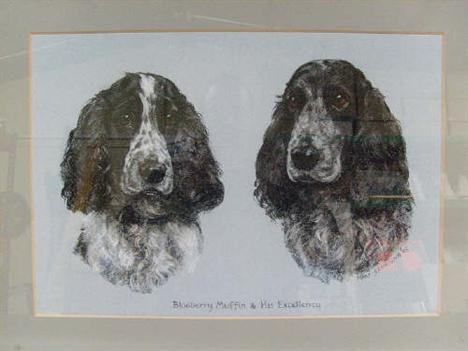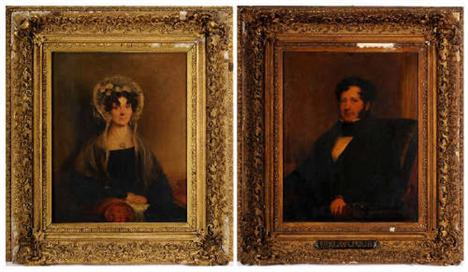283284 Preisdatenbank Los(e) gefunden, die Ihrer Suche entsprechen
283284 Lose gefunden, die zu Ihrer Suche passen. Abonnieren Sie die Preisdatenbank, um sofortigen Zugriff auf alle Dienstleistungen der Preisdatenbank zu haben.
Preisdatenbank abonnieren- Liste
- Galerie
-
283284 Los(e)/Seite
A lady’s Continental fob watch, having white enamel dial with gilt scroll work and Roman numerals, in 14k gold floral chased case, together with a memorial stick pin, the porcelain oval finial painted with a portrait of an elderly gentleman, in yellow metal rope twist surround with vacant glass back, in fitted case, 4 1/2" long (2)
A Victorian white overlay ruby glass vase, of elongated ovoid form having alternating hob cut and floral gothic shaped panels, on circular foot with gilt embellishment, 11 1/2" high (repaired), together with a Victorian ruby and gilt glass vase, applied with an opaque white panel painted with a head and shoulders female portrait, on replaced circular wooden foot, 14 1/2" high and a Bohemian green and white overlay part table lamp, 10 1/2" high (3)
William Derby & R W Satchwell (18/19th century) & Jansen Derby (19th century), A set of eight portraits: Charlotte Dela Tremouille, Countess of Derby after Van Dyke, by William Derby circa 1823; The 1st Earl of Worcester by Jansen Derby; Catherine, Queen of Charles II after the original by Peter Lely, by William Derby; Percy, Earl of Northumberland, after Van Dyke by R W Satchwell; Nicholas Ridley, Bishop of London, by William Derby; King Charles II after Peter Lely by William Derby; Algernon Pevey, 1st Earl of Northumberland, by William Derby; Thomas Wentworth, Earl of Stafford, after Van Dyke by R W Satchwell, each inscribed on the reverse, watercolours, each 17.5 x 14cm. (8). Footnote: R W Satchwell, 18/19th Century, English School, exhibited 1793 -1818. William Derby (1786-1847), portrait painter, pupil of Joseph Barker. Lord Derby commissioned the artist to paint copies of his ancestors.
John Bridges (19th century), 'Little Betsie', portrait of Elizabeth Joy Spiers in fancy dress, signed and dated 1845 centre right, oil on board, Inscribed on an old label attached to the reverse: 'This portrait of Little Betsie is for my own dear Husband with the fond and affectionate love his very devoted wife, Elizabeth, Oct. 25th 1845', 29 x 23.5cm. * Exhibited: The Victorian Exhibition in aid of St Bartholemew's Hospital, 1931.
John Bridges (19th century), Portrait of Mrs Richard James Spiers and her eldest son, Richard Phene-Spiers holding a silver and coral rattle, full-length, seated in an interior, a hound at their feet and a view through a window beyond, signed and dated 1836 bottom right, inscribed on a label attached to the reverse, oil on panel, 59 x 49.5cm. ** Historical Note: The circular stool to the left of the figure in lot 517, and also depicted in lot 518, is the same stool offered in this sale, lot 688. This is a charming insight into the production of these family portraits by Bridges who, over a nearly decade, 1836-1845, was obviously a favoured artist of the Spiers family. The stool, which dates from the period, is ornate and decorative and was clearly an admired possession within the household
John Bridges, (19th century), Portrait of Richard James Spiers, Sheriff of Oxford 1851, Mayor of Oxford 1853, half- length seated, in an interior, signed and dated 1838 lower right, oil on panel, 37 x 29cm; together with a companion portrait of Catherine Spiers, née Sirman, a pair and one other family portrait of a gentleman (3)
Nicholas Condy (British 1799-1857), 'Schooling'; an interior with a mother and child at a table, oil on panel, 29.5 x 24.5cm. Nicholas Condy was born in Plymouth and enlisted in the army as a young man. On his discharge in 1818 he returned to Plymouth to take up painting professionally and married the daughter of Captain Oates, a portrait painter from Falmouth. Condy painted both in oils and watercolours, his subject matter ranging from marine, to landscape and cottage interiors. The cottage interiors were highly finished and detailed; composed in thin glazes and looking towards 18th century Continental school examples rather than to his contemporaries. The main subject in these compositions was surrounded by minutely observed still life details, contrasting with contemporaries, like Wheatley and Morland. It was said, Condy died from grief at the premature death of his son Nicholas Matthew Condy (1816-1851), who had become a talented and successful marine artist in his own right.
Edouard Lantern (1848-1917). A bronze relief portrait plaque of R. Phene Spiers, the panel below inscribed 'A record of The Esteem Of His Pupils Colleagues and Friends' with matching plaque of ancient ruins inscribed 'The Greatest Trust Between Man And Man Is The Trust Of Giving Counsel', both plaques contained in an oak frame, each plaque 27 x 20cm, overall dimensions 36 x 52cm.
An imposing Aesthetic Movement parcel-gilt walnut library bookcase by Lamb of Manchester, crossbanded throughout and inlaid with panels of stylised flowers, foliage, birds and motifs, the galleried superstructure above three arched glazed doors and a recess flanked by panelled doors centred by carved boxwood portrait roundels, 'History' and 'Poetry', small glazed doors below, the base with four frieze drawers and three panelled doors flanked by eight drawers and on plinth bases, 225cm (7ft 4½in) wide x 272cm (8ft 11in) high, the locks and drawers stamped 'LAMB. MANCHESTER'. * James Lamb (1816-1903) was the leading Manchester cabinet maker of the Victorian period and established a large workshop in the city. The company successfully exhibited at the 1862 London Universal Exhibition and the 1867 and 1878 Paris Exhibition. An important figure in the Aesthetic Movement, Lamb worked in association with important designers including Bruce Talbot, Charles Bevan and Alfred Waterhouse (furniture for the Manchester Assize Courts, shown at the Paris Exposition). The firm's name has long been held synonymous with the best quality workmanship and materials and innovative design.
French Louis XVI style mantel clock, circa 1880, the case of gilt brass and blue enamelled ceramic, circular dial painted with a fishing cherub surmounted by a portrait medallion, on a leaf scroll base set with a panel of two cherubs beside water, twin barrel movement striking the half, Brocot suspension, circular backplate signedA.D for A. Dumas of Paris. Width 36cm.
JOSEPH CRAWHALL SENIOR 'CAPTAIN LEMUEL GULLIVER' AND 'GUIDO FAWKES' PLATTERS, DATED 1879 painted earthenware, each of circular form, one painted with the figure of Guy Fawkes and bearing inscription "The lively portraiture of the truly pious, learned and judicious gentleman Guido Fawkes ...etc." painted mark verso "Jos Crawhall/ Jan '79" with bearded man monogram; the other plate inscribed 'Captain Lemuel Gulliver', painted with a portrait of Lemuel Gulliver and bearing inscription "Drake and Columbus long th' unknown Shoar, Vespucci, at his best - but half seas o'er ...etc." inscribed verso 'Joseph Crawhall/ Newcastle-on-Tyne/ Jan 1879' with bearded man monogram (2) 31cm diameter Literature: Felver, C.S. 'Joseph Crawhall, The Newcastle Wood Engraver', published Frank Graham, Newcastle 1972 Note: Joseph Crawhall (1821-1896) was a distinguished English woodcut engraver. Copies of his most amusing verse were painted on china of which this lot is an example. Crawhill's work "carries the same freshness of co our and boldness and informality of touch that was so much a part of the work of William Nicholson and James Pryde, the Beggarstaff brothers, at the turn of the (20th) century. They in turn derived much of their inspiration for working in bold colours and broad lines from Joseph Crawhall. "In his work he often collaborated with his son Joseph, who in turn influenced and was influenced by his contemporaries E A Walton, George Henry, and the other Glasgow Boys.
CLARE SHERIDAN BUST OF A WOMAN bronze, signed in the bronze and dated 1949 42cm high Note; Clare Sheridan was a cousin of Sir Winston Churchill whom she embarrassed by her wild behaviour and belief in free love. She married in 1910 and had three children, one of whom died in 1914. Grief-stricken, she modelled an angel for her child's grave and discovered a talent for sculpture. After the death of her husband in the First World War, she began exhibiting her portrait sculptures, including one of Churchill, created while he painted her. An admirer of communism, she travelled in secret to the Soviet Union in 1920. There she sculpted Lenin and Trotsky, later publishing her diary of the trip. She then went to Mexico and America, where she settled, becoming friends with Charlie Chaplin. Next she turned to journalism, interviewing senior European figures for the American press. Her second trip to Russia, in 1923, proved disillusioning. She took her children to live first in Turkey and then on the edge of the Sahara in Algeria. After the Second World War she became a Roman Catholic. She continued to sculpt and to write her memoirs.
-
283284 Los(e)/Seite













































